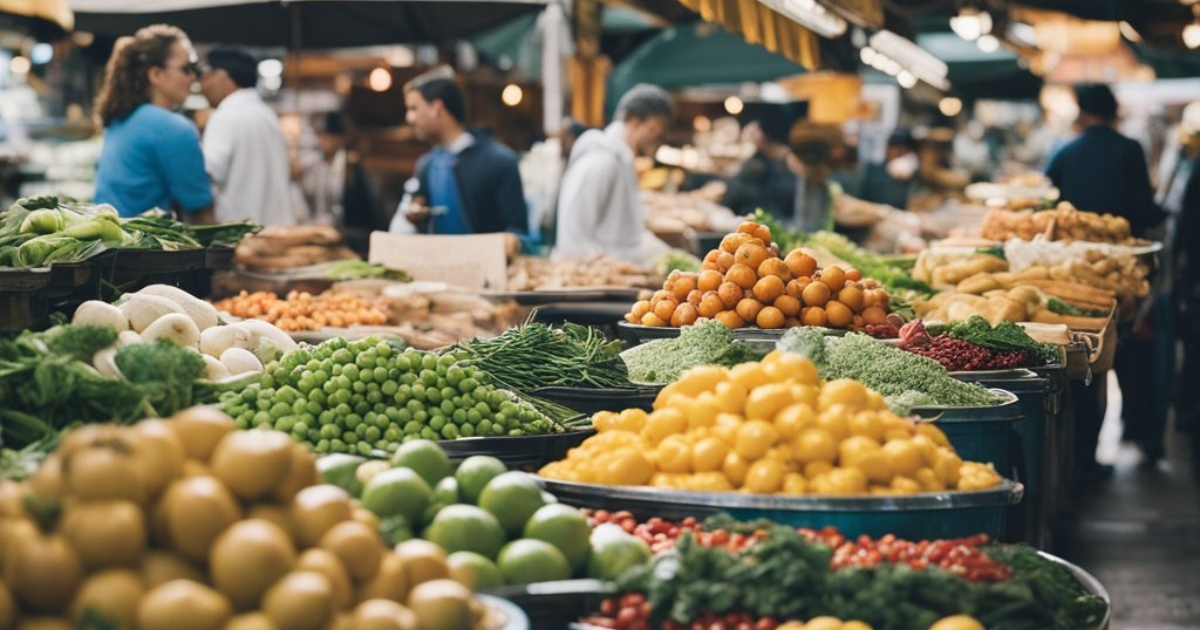Food
Melissa Leong’s Surprise Exit from MasterChef Australia: The Inside Story

Sad News for all MasterChef Australia fans!
Melissa Leong, a high-profile food critic and MasterChef Australia judge since 2019, won’t be returning as a judge for the 16th season of MasterChef Australia 2024.
According to the broadcaster, though she has been pulled out from the popular Channel Ten program but remains an important part of the television network.
Leong joined MasterChef with co-hosts Andy Allen and Jock Zonfrillo in 2019 after the abrupt exit of Matt Preston, Gary Mehigan and George Calombaris caused by a dispute over exclusivity and pay.
Melissa Leong Clarifies Her Departure from MasterChef AU
In a lengthy social media post, the celebrated chef thanked the network for its continued support while clarifying that she was not axed from the program as reported, but rather she was “stepping away” on her own terms.
“My time as co-host and judge on @MasterChefAU has been a great gift. To have been given the opportunity to learn and grow – and now to be given the vote of confidence to expand and evolve the MasterChef universe is huge!”
Leong wrote alongside a Season 2 promo photo of her on Ten’s food program, Dessert Masters Australia, which she will co-host with pastry chef Amaury Guichon.
“Stepping away from the main show and into #DessertMastersAU alongside the extraordinary @AmauryGuichon, is yet another sweet present indeed.”
The major shake-up sees Leong replaced by 2009 MasterChef runner-up Poh Ling Yeow and Michelin star chef Jean-Christophe Novelli, who will appear alongside returning star Andy Allen and food critic Sofia Levin as a fourth judge.
“It is with great warmth and enthusiasm that I wish this new line-up of judges and hosts all the best in making it theirs, and big love to @andyallencooks for leading the way,” Leong added.
“The changing of the guard is one I always planned to embrace, and I’m so glad to do that, on my terms, today.”
Leong said she was also “excited” for what the next chapter holds as she has been “working on behind the scenes” projects she can soon share with fans.
“My gratitude to our audience for all your support, can’t wait for you to see the new show. Love and respect always,” she concluded.
Channel 10’s Reassurance: Melissa Leong’s Ongoing Role in the MasterChef Australia Family
Channel 10 has since released a statement on her surprise departure, in which they insisted Leong will remain a member of the MasterChef family.
“Melissa Leong remains a key member of the MasterChef Australia family. Melissa is set to return for a second season of Dessert Masters in 2024, alongside fellow judge and pastry prodigy Amaury Guichon,” the statement read.
“Next year, MasterChef Australia and Dessert Masters will air back-to-back, therefore each show needs its own distinct style and personality and its own unique hosting team.”
Jock Zonfrillo’s Tragic Passing
The line-up was rocked in April this year when Zonfrillo died suddenly on the eve of the show’s new season.
Zonfrillo was found dead by police in a Melbourne hotel room, and it was later determined he died of natural causes. He was 46.
“Four years ago, the three of us stood on a precipice and leapt together,” she wrote in tribute to Zonfrillo.
“I could never have guessed how much of an impact your arrival in my life would have, or that we would be saying goodbye to you so soon. You were always supposed to be the bulletproof one who outlived us all.”
Recently, celebrity chef Jamie Oliver was in the news to be promoted as a judge for the 16th season of the MasterChef AU 2024, however, we just found out that it was just a rumor.
Dessert Masters: Leong’s New Culinary Adventure
Channel Ten’s newest program, Dessert Masters, is also hosted by Leong and will premiere on November 12. The MasterChef spin-off runs for a far shorter duration and is not distributed into international markets (MasterChef is broadcast in 60 countries).
A Network 10 spokesman said the decision was due to the way Leong’s two programs were scheduled.
MasterChef is one of the most expensive productions on Australian TV – it is estimated to cost the network about $30 million a season. The hosts are estimated to be paid about $1 million per season.
Food
Why is Cambodian Food So Bad?

The Unique Flavors of Cambodian Food
Cambodian food is characterized by its unique blend of flavors, combining elements of sweet, sour, salty, and bitter. The extensive use of fresh herbs, aromatic spices, and fermented fish sauce (known as prahok) creates a distinct umami taste that sets Cambodian cuisine apart. The dishes are often vibrant and bold, showcasing the country’s rich culinary heritage.The Influence of History and Geography on Cambodian Cuisine
Cambodia’s culinary traditions have been shaped by its history and geography. Situated in the heart of Southeast Asia, Cambodian cuisine has been influenced by neighboring countries like Thailand, Vietnam, and Laos, while also retaining its own distinct identity. The country’s fertile lands and access to freshwater sources have influenced the ingredients used in Cambodian cooking, resulting in a cuisine that celebrates local produce and seafood.Debunking the Myth: Cambodian Food is Delicious
The Rich and Varied Ingredients
Contrary to the belief that Cambodian food is bad, the cuisine boasts a wide array of rich and varied ingredients. From aromatic herbs like lemongrass, galangal, and kaffir lime leaves to fresh vegetables like morning glory, eggplant, and water spinach, Cambodian dishes are bursting with flavors. The use of tropical fruits like pineapple, mango, and papaya adds a refreshing sweetness to many dishes.The Balance of Flavors
One of the hallmarks of Cambodian cuisine is the skillful balance of flavors. Dishes often combine sweet, sour, salty, and bitter elements, creating a harmonious and complex taste profile. This balance is achieved through the judicious use of ingredients like palm sugar, tamarind, fish sauce, and a variety of herbs and spices.The Culinary Heritage
Cambodian cuisine is deeply rooted in the country’s cultural heritage, with recipes and cooking techniques passed down through generations. Traditional dishes like amok (a rich and creamy coconut-based curry), nom banh chok (Cambodian rice noodle soup), and prahok k’tis (a dip made from fermented fish) showcase the ingenuity and creativity of Cambodian cooks in utilizing locally available ingredients.Reasons Behind the Negative Perception
Limited Exposure and Availability
One of the primary reasons behind the negative perception of Cambodian food is its limited exposure and availability outside of Cambodia. Compared to its neighboring cuisines, Cambodian restaurants and food products are less prevalent globally, leading to a lack of familiarity and understanding among many people.Misconceptions and Stereotypes
Misconceptions and stereotypes about Cambodian cuisine have also contributed to the negative perception. Some people mistakenly associate Cambodian food with being overly spicy, overly fishy, or lacking in variety. These misconceptions often stem from a lack of knowledge and exposure to the diverse range of Cambodian dishes.Personal Preferences and Cultural Differences
Personal preferences and cultural differences can also play a role in shaping perceptions about Cambodian food. Flavors and ingredients that may be unfamiliar or unusual to some palates can lead to initial aversion or dislike. However, an open mind and willingness to explore new culinary experiences can help overcome these barriers.The Diversity of Cambodian Cuisine
Regional Specialties
Cambodia is a country with diverse regions, each with its own unique culinary traditions and specialties. From the coastal regions known for their fresh seafood dishes to the rural areas celebrated for their flavorful curries and stews, Cambodian cuisine offers a wide range of flavors and cooking styles.Influence of Neighboring Cuisines
While Cambodian cuisine has its own distinct identity, it has also been influenced by neighboring cuisines over the centuries. Thai, Vietnamese, and Chinese influences can be seen in various Cambodian dishes, adding depth and complexity to the culinary landscape.Street Food Culture
No discussion of Cambodian cuisine would be complete without mentioning the vibrant street food culture. From sizzling satay skewers to fragrant noodle soups, street vendors offer a delicious and affordable way to experience the flavors of Cambodia. The street food scene is a testament to the country’s love for fresh, flavorful, and diverse culinary offerings.Embracing the Flavors of Cambodia
Authentic Cambodian Restaurants
To truly appreciate the flavors of Cambodian cuisine, seeking out authentic Cambodian restaurants is crucial. These establishments, often run by Cambodian families or chefs, offer a genuine taste of the country’s culinary traditions. From the decor to the cooking techniques, authentic Cambodian restaurants provide an immersive experience that can help dispel negative perceptions.Cooking Classes and Food Tours
Participating in cooking classes or food tours is another excellent way to gain a deeper understanding and appreciation for Cambodian food. These interactive experiences not only teach the art of preparing traditional dishes but also provide insights into the cultural significance and history behind the cuisine.Exploring the Local Markets
Visiting local markets in Cambodia is a feast for the senses. From the vibrant displays of fresh produce to the tantalizing aromas of street food stalls, these markets offer a glimpse into the heart of Cambodian culinary culture. Exploring these markets can be an eye-opening experience, showcasing the diversity and vibrancy of Cambodian ingredients and dishes. People Also Read:Conclusion: Appreciating Cambodian Food
Cambodian cuisine is a rich and flavorful culinary tradition that deserves recognition and appreciation. While negative perceptions may exist due to limited exposure, misconceptions, and personal preferences, an open mind and willingness to explore can reveal the deliciousness and diversity of this cuisine. From the balance of flavors to the culinary heritage, Cambodian food offers a unique and satisfying dining experience. By seeking out authentic restaurants, participating in cooking classes or food tours, and exploring local markets, one can truly embrace and appreciate the flavors of Cambodia.FAQs
Is Cambodian food spicy? Cambodian cuisine is known for its balance of flavors, including spicy elements. However, the level of spiciness can vary greatly depending on the dish and individual preferences. Many Cambodian dishes incorporate chili peppers, but the heat level is often milder than in neighboring cuisines like Thai food. Diners can typically adjust the spice level to their liking. Is Cambodian food vegetarian/vegan-friendly? While Cambodian cuisine traditionally incorporates meat, fish, and dairy products, there are many vegetarian and vegan-friendly options available. Buddhist influences have led to the development of numerous plant-based dishes, such as stir-fried vegetables, vegetarian curries, and meat-free variations of popular dishes like amok. What are the common ingredients used in Cambodian cooking? Some of the common ingredients used in Cambodian cooking include lemongrass, galangal, kaffir lime leaves, turmeric, prahok (fermented fish sauce), coconut milk, palm sugar, tamarind, and a variety of fresh herbs like mint, cilantro, and basil. Cambodian cuisine also heavily relies on fresh vegetables, fruits, and proteins like chicken, beef, and seafood. Where can I find authentic Cambodian restaurants outside of Cambodia? Authentic Cambodian restaurants can be found in major cities with significant Cambodian communities, such as Long Beach and San Francisco in the United States, or Paris and Montreal in Europe. Additionally, many major cities with diverse culinary scenes may have a few Cambodian eateries or food trucks. Research and recommendations from locals or food enthusiasts can help locate the best spots to experience authentic Cambodian flavors.Food
Which Item Does Not Have a Food Contact Surface?

Understanding which items in your kitchen have food contact surfaces is crucial for maintaining proper food safety and hygiene. A food contact surface is any surface that comes into direct contact with food during preparation, cooking, serving, or storage. Identifying these surfaces is essential to prevent cross-contamination and ensure that your food remains safe for consumption.
In this article, we’ll explore various kitchen items and categorize them based on whether they have food contact surfaces or not. By the end, you’ll have a clear understanding of which item does not have a food contact surface, allowing you to prioritize cleaning and sanitization efforts accordingly.
A food contact surface is any surface that comes into direct contact with food during preparation, cooking, serving, or storage. These surfaces can harbor harmful bacteria, viruses, and other contaminants if not properly cleaned and sanitized. Failing to maintain food contact surfaces can lead to foodborne illnesses, which can range from mild discomfort to severe health issues.
Understanding which items have food contact surfaces is crucial for maintaining a safe and hygienic kitchen environment. By identifying these items, you can prioritize cleaning and sanitization efforts, reducing the risk of cross-contamination and ensuring that your food remains safe for consumption.
Kitchen Utensils
Kitchen utensils are essential tools for food preparation and cooking. Many of these items have direct contact with food, making them potential sources of contamination if not properly cleaned and sanitized.
Cutting Boards
Cutting boards are one of the most common food contact surfaces in the kitchen. Whether you’re chopping vegetables, slicing meat, or cutting fruits, your cutting board comes into direct contact with raw and cooked foods. Proper cleaning and sanitization of cutting boards are crucial to preventing the spread of harmful bacteria and cross-contamination.
Knives
Like cutting boards, knives are also considered food contact surfaces. As you slice and dice various ingredients, your knives come into direct contact with the food. Proper cleaning and sanitization of knives are essential to maintaining food safety and preventing cross-contamination.
Pots and Pans
Pots and pans are used for cooking a wide variety of foods, from sautéing vegetables to boiling pasta. During the cooking process, these items come into direct contact with the food, making them food contact surfaces. Ensuring that your pots and pans are properly cleaned and sanitized after each use is crucial to maintaining food safety.
Serving Utensils (Spoons, Ladles, etc.)
Serving utensils, such as spoons, ladles, and tongs, are used to handle and serve food. These items come into direct contact with cooked or prepared foods, making them food contact surfaces. Proper cleaning and sanitization of serving utensils are essential to prevent the spread of harmful bacteria and cross-contamination.
Appliances
In addition to kitchen utensils, many appliances in your kitchen also have food contact surfaces. Identifying these surfaces and properly cleaning and sanitizing them is crucial for maintaining a safe and hygienic kitchen environment.
Blenders and Food Processors
Blenders and food processors are commonly used to blend, chop, or puree various ingredients. The blades, pitchers, and bowls of these appliances come into direct contact with food, making them food contact surfaces. Proper cleaning and sanitization of these components are essential to prevent cross-contamination and ensure food safety.
Microwaves
While the exterior of a microwave may not come into direct contact with food, the interior surfaces do. When reheating or cooking food in the microwave, the turntable, interior walls, and ceiling can become contaminated with food particles or splashes. Regularly cleaning and sanitizing the interior of your microwave is crucial to maintain food safety.
Ovens
Ovens are used for baking, roasting, and cooking a variety of foods. While the exterior of the oven may not come into direct contact with food, the interior surfaces, such as oven racks and walls, are considered food contact surfaces. Proper cleaning and sanitization of these surfaces are essential to prevent the buildup of food residue and potential contamination.
Refrigerators
Refrigerators are used to store both raw and cooked foods. While the exterior of the refrigerator is not a food contact surface, the interior shelves, drawers, and walls can come into contact with food or food residue. Regularly cleaning and sanitizing the interior of your refrigerator is crucial to prevent cross-contamination and maintain food safety.
Tableware
Tableware, including plates, bowls, cups, mugs, and silverware, are all considered food contact surfaces. These items come into direct contact with food during serving and eating, making them potential sources of contamination if not properly cleaned and sanitized.
Plates and Bowls
Plates and bowls are used to serve and hold food during meals. As they come into direct contact with food, they are considered food contact surfaces. Proper cleaning and sanitization of plates and bowls are essential to prevent the spread of harmful bacteria and cross-contamination.
Cups and Mugs
Cups and mugs are used for serving and consuming beverages, such as coffee, tea, and juices. While these items may not come into direct contact with solid foods, they can still harbor harmful bacteria and contaminants if not properly cleaned and sanitized.
Silverware
Silverware, including forks, knives, and spoons, are used during meals to handle and consume food. As they come into direct contact with food, they are considered food contact surfaces. Proper cleaning and sanitization of silverware are crucial to maintaining food safety and preventing cross-contamination.
Food Storage Containers
Food storage containers are used to store and preserve both raw and cooked foods. Identifying which containers have food contact surfaces and properly cleaning and sanitizing them is essential to maintaining food safety and preventing cross-contamination.
Plastic Containers
Plastic containers are commonly used for storing leftovers, prepped ingredients, and other food items. The interior surfaces of these containers come into direct contact with food, making them food contact surfaces. Proper cleaning and sanitization of plastic containers are crucial to preventing the buildup of food residue and potential contamination.
Glass Containers
Glass containers, such as jars and storage bowls, are also used for storing food items. Like plastic containers, the interior surfaces of glass containers come into direct contact with food, making them food contact surfaces. Proper cleaning and sanitization of glass containers are essential to maintaining food safety and preventing cross-contamination.
Metal Containers
Metal containers, such as cans and tins, are often used for storing and preserving certain food items. While the exterior of these containers may not come into direct contact with food, the interior surfaces do. Proper cleaning and sanitization of metal containers are crucial to preventing the buildup of food residue and potential contamination.
Non-Food Contact Items
While many items in your kitchen are considered food contact surfaces, there are also items that do not come into direct contact with food. Identifying these non-food contact items is important to prioritize your cleaning and sanitization efforts effectively.
Oven Mitts and Pot Holders
Oven mitts and pot holders are used to handle hot cookware and bakeware, but they do not come into direct contact with food. These items are not considered food contact surfaces, but they should still be cleaned regularly to maintain a hygienic kitchen environment.
Dish Towels
Dish towels are used for drying dishes, wiping down countertops, and cleaning up spills. While they may come into contact with food residue or water used for cleaning food contact surfaces, dish towels themselves are not considered food contact surfaces. However, it’s essential to wash dish towels regularly to prevent the buildup of bacteria and maintain a clean kitchen.
Cleaning Supplies
Cleaning supplies, such as sponges, brushes, and cleaning solutions, are used to clean and sanitize food contact surfaces and other areas of the kitchen. While these items may come into contact with food residue during the cleaning process, they are not considered food contact surfaces themselves. Proper handling and storage of cleaning supplies are crucial to prevent cross-contamination.
Decorative Items
Decorative items, such as vases, picture frames, and candle holders, are not considered food contact surfaces as they do not come into direct contact with food. However, these items should still be cleaned regularly to maintain a clean and hygienic kitchen environment.
Importance of Proper Cleaning and Sanitization
Identifying which items have food contact surfaces is only the first step in maintaining a safe and hygienic kitchen. Proper cleaning and sanitization of these surfaces are crucial to prevent cross-contamination and ensuring food safety.
Preventing Cross-Contamination
Cross-contamination occurs when harmful bacteria or other contaminants are transferred from one surface to another. This can happen when food contact surfaces are not properly cleaned and sanitized, leading to the spread of foodborne illnesses. By properly cleaning and sanitizing food contact surfaces, you can significantly reduce the risk of cross-contamination and protect your family’s health.
Food Safety Guidelines
Several government agencies, such as the U.S. Food and Drug Administration (FDA) and the Centers for Disease Control and Prevention (CDC), provide guidelines and recommendations for maintaining food safety in the kitchen. These guidelines often emphasize the importance of properly cleaning and sanitizing food contact surfaces, as well as following safe food handling practices.
By adhering to these guidelines, you can ensure that your kitchen remains a safe and hygienic environment for food preparation and consumption.
People Also Read:
Conclusion
Understanding which items in your kitchen have food contact surfaces is crucial for maintaining proper food safety and hygiene. By identifying these surfaces and prioritizing their cleaning and sanitization, you can significantly reduce the risk of cross-contamination and foodborne illnesses.
Remember, items like cutting boards, knives, pots, pans, serving utensils, blenders, food processors, ovens, refrigerators, tableware, and food storage containers all have food contact surfaces that require proper cleaning and sanitization. On the other hand, items such as oven mitts, pot holders, dish towels, cleaning supplies, and decorative items do not have direct food contact surfaces but should still be kept clean and maintained.
By following proper cleaning and sanitization procedures and adhering to food safety guidelines, you can ensure a safe and hygienic kitchen environment for you and your family.
FAQs
What is the difference between cleaning and sanitizing?
Cleaning involves removing visible dirt, food residue, and other debris from surfaces, while sanitizing is the process of reducing the number of harmful microorganisms to safe levels through the use of chemical sanitizers or heat.
How often should I clean and sanitize food contact surfaces?
It’s recommended to clean and sanitize food contact surfaces before and after each use, as well as at the end of the day. Additionally, any surfaces that come into contact with raw meat, poultry, or seafood should be cleaned and sanitized immediately after use.
What types of cleaners and sanitizers should I use?
Look for cleaners and sanitizers that are approved for use in food preparation areas and follow the manufacturer’s instructions for proper dilution and contact time. Common sanitizers include chlorine-based solutions, quaternary ammonium compounds, and food-grade hydrogen peroxide.
Can I use the same sponge or cloth for cleaning food contact surfaces and non-food contact surfaces?
It’s best to use separate sponges or cloths for cleaning food contact surfaces and non-food contact surfaces to prevent cross-contamination. Consider color-coding your cleaning tools to distinguish between different areas of the kitchen.
How can I ensure that my kitchen is safe from cross-contamination?
In addition to properly cleaning and sanitizing food contact surfaces, follow safe food handling practices such as separating raw and cooked foods, cooking foods to the appropriate internal temperature, and storing foods at the correct temperatures. Additionally, wash your hands frequently with soap and water, especially after handling raw meat, poultry, or seafood.
Food
What Food is Pittsburgh Known For: A Delicious Journey Through Steel City’s Iconic Eats

If you’re a food lover, Pittsburgh is a city that should be on your radar. Known for its rich cultural heritage, vibrant neighborhoods, and, of course, its mouthwatering cuisine, this city has a food scene that will tantalize your taste buds like no other. From classic comfort foods to innovative fusion dishes, what food is Pittsburgh known for? Buckle up, because we’re about to embark on a delicious journey through Steel City’s iconic restaurants.
The Quintessential Pittsburgh Foods
The Iconic Pittsburgh Sandwich: The Primanti Bros.
No discussion of Pittsburgh’s culinary scene is complete without mentioning the legendary Primanti Bros. sandwich. This behemoth of a sandwich is a true testament to the city’s blue-collar roots, with its ingenious combination of Italian bread, capicola, provolone cheese, french fries, and coleslaw – all stacked together in a delicious, carb-loaded tower.
The Experience of Eating a Primanti Bros. Sandwich
Biting into a Primanti Bros. sandwich is a rite of passage for any Pittsburgh visitor or resident. It’s a messy, indulgent affair that requires both hands and a healthy appetite. But the flavors, the textures, and the sheer satisfaction it delivers are worth every calorie.
Pittsburgh’s Proud Polish Heritage: The Pierogi
Pittsburgh’s strong Polish heritage has left an indelible mark on its food scene, and no dish embodies this better than the beloved pierogi. These delightful dumplings, stuffed with savory fillings like potato, cheese, or sauerkraut, are a staple in many Pittsburgh households and restaurants.
The Best Places to Enjoy Pierogi in Pittsburgh
From family-owned businesses like Pierogies Plus to the annual Pierogi Fest, Pittsburgh offers no shortage of opportunities to indulge in these little pockets of deliciousness. Whether boiled, fried, or baked, the pierogi is a beloved part of Pittsburgh’s culinary fabric.
Pittsburgh’s Diverse Culinary Influences
Italian Roots: Pizza, Pasta, and More
With a strong Italian-American community, Pittsburgh has developed a deep appreciation for Italian cuisine. From neighborhood pizzerias serving up authentic Neapolitan-style pies to family-run pasta joints, the city’s Italian food scene is a testament to its rich heritage.
The Best Pizza Spots in Pittsburgh
Whether you prefer a classic Margherita or a loaded creation with all the toppings, Pittsburgh has a pizza spot that will satisfy your cravings. Places like Mineo’s Pizza House and Franktuary have garnered a cult following for their delectable pies.
Beyond Pizza: Italian Delis and Bakeries
Pittsburgh’s Italian food scene extends far beyond pizza. Explore neighborhood gems like Groceria Italiana and Sunseri’s for imported Italian goods, freshly made pasta, and mouthwatering baked goods like cannoli and sfogliatelle.
The Melting Pot: Fusion and International Cuisines
Pittsburgh’s diverse population has given rise to a thriving international food scene, where fusion cuisines and global flavors thrive. From Korean-Mexican fusion to authentic Ethiopian fare, the city’s dining options are a true melting pot of cultures and flavors.
Pittsburgh’s Thriving Asian Food Scene
With neighborhoods like Squirrel Hill and Oakland, Pittsburgh boasts a vibrant Asian food scene. Explore the flavors of Thai, Chinese, Japanese, and more at spots like Bangkok Balcony, Everyday Noodles, and Taiwanese Bistro Café 33.
Middle Eastern and Mediterranean Flavors
Pittsburgh’s food scene also celebrates the rich flavors of the Middle East and Mediterranean. From the falafel and shawarma at Tahini Cafe to the authentic Greek dishes at Lulu’s Nailhouse, these cuisines offer a delicious escape to distant lands.
Pittsburgh’s Iconic Desserts and Sweets
The Delectable World of Pittsburgh Cookies
No Pittsburgh food experience is complete without indulging in the city’s iconic cookie scene. From the famous Prantl’s Burnt Almond Torte to the irresistible thumbprint cookies at Oakmont Bakery, these sweet treats are a local obsession.
The History and Tradition of Pittsburgh Cookies
Pittsburgh’s love affair with cookies dates back generations, with family recipes and bakery traditions passed down through the years. These cookies are not just desserts; they’re a part of the city’s cultural fabric.
The Best Places to Indulge in Pittsburgh Cookies
Whether you’re a fan of classic chocolate chip or prefer more unique flavors like peanut butter smidgen or lemon cooler, Pittsburgh’s bakeries and cafés offer a delectable array of cookie options to satisfy any sweet tooth.
The Iconic Pittsburgh Ice Cream Treats
When the weather warms up, Pittsburghers flock to their favorite ice cream spots for refreshing and iconic treats. From the legendary ice cream cookie sandwiches at Eat’n Park to the decadent milkshakes at Cure, Pittsburgh’s ice cream game is strong.
The History of Pittsburgh’s Ice Cream Traditions
Ice cream has been a beloved part of Pittsburgh’s food culture for generations, with local creameries and soda fountains serving up innovative and indulgent creations for decades.
The Must-Try Ice Cream Spots in Pittsburgh
Whether you prefer a classic scoop or a towering sundae, Pittsburgh has no shortage of places to indulge your ice cream cravings. Spots like Dave & Andy’s and Gaby et Jules offer unique flavors and creative concoctions that will have you coming back for more.
Pittsburgh’s Food Festivals and Events
The Annual Celebration of Pittsburgh’s Iconic Foods
Pittsburgh takes its food seriously, and the city’s annual food festivals and events are a testament to this. From the beloved Pierogi Fest to the Rib Fest and the Pittsburgh VegFest, these celebrations bring together locals and visitors alike to indulge in the city’s culinary offerings.
The Pierogi Fest: A Celebration of Pittsburgh’s Polish Heritage
The Pierogi Fest is a beloved annual event that pays homage to Pittsburgh’s Polish roots and the city’s love for these delicious dumplings. Attendees can sample a variety of pierogi flavors, watch pierogi-making demonstrations, and even participate in pierogi-eating contests.
Other Iconic Food Festivals in Pittsburgh
From the Pittsburgh Taco Fest to the Burgher Brew Bash, Pittsburgh’s food festivals showcase the city’s diverse culinary scene and offer a chance to sample unique and delicious offerings from local restaurants and vendors.
Food Tours: Exploring Pittsburgh’s Culinary Neighborhoods
For those who want to truly immerse themselves in Pittsburgh’s food scene, food tours are the perfect way to explore the city’s vibrant neighborhoods and culinary gems. These guided tours offer a behind-the-scenes look at the city’s food culture, with stops at local eateries, markets, and bakeries.
The Iconic Neighborhoods to Explore on a Pittsburgh Food Tour
From the Strip District, known for its bustling markets and international flavors, to the charming Lawrenceville neighborhood, with its trendy eateries and craft breweries, Pittsburgh’s food tours take you on a culinary journey through the city’s diverse communities.
The Benefits of Taking a Pittsburgh Food Tour
Food tours not only provide a delicious way to experience Pittsburgh’s culinary scene but also offer insights into the city’s history, culture, and local traditions. You’ll get to meet the passionate chefs, entrepreneurs, and restaurateurs who are shaping Pittsburgh’s food landscape.
People Also Read:
Conclusion
Pittsburgh’s food scene is a delicious tapestry of tradition, innovation, and cultural diversity. From the iconic Primanti Bros. sandwich and pierogi to the city’s thriving international cuisine and beloved desserts, this city has something to offer every food lover. Whether you’re a lifelong Pittsburgher or a first-time visitor, exploring what food is Pittsburgh known for is a journey that will leave you satisfied, inspired, and craving more. So, pack your appetite and get ready to experience the flavors that make Steel City truly special.
FAQs
What is the most iconic Pittsburgh food?
The Primanti Bros. sandwich is widely considered the most iconic and quintessential Pittsburgh food. This towering sandwich, featuring Italian bread, meat, cheese, french fries, and coleslaw, is a beloved part of Pittsburgh’s culinary heritage and a must-try for any visitor.
Where can I find the best pierogi in Pittsburgh?
Pittsburgh is home to numerous excellent pierogi spots, but some local favorites include Pierogies Plus in McKees Rocks, Stuff’d Pierogi Truck, and the annual Pierogi Fest. Many family-owned Polish restaurants and bakeries also offer delicious homemade versions of this beloved dumpling.
Are there any unique Pittsburgh desserts or sweets I should try?
Absolutely! Pittsburgh has a thriving cookie scene, with iconic treats like the Prantl’s Burnt Almond Torte, thumbprint cookies from Oakmont Bakery, and the famous ice cream cookie sandwiches from Eat’n Park. The city’s milkshakes and sundaes are also renowned, with spots like Cure and Dave & Andy’s offering decadent creations.
Can vegetarians and vegans find good food options in Pittsburgh?
Yes, Pittsburgh has embraced the plant-based movement, and there are plenty of excellent vegetarian and vegan options available. Check out eateries like Apteka, Onion Maiden, and Randita’s for delicious meat-free dishes. The annual Pittsburgh VegFest is also a great event to explore the city’s vegan and vegetarian food scene.
What is the best way to experience Pittsburgh’s diverse culinary offerings?
Taking a food tour is an excellent way to immerse yourself in Pittsburgh’s culinary scene and explore different neighborhoods and cuisines. These guided tours offer behind-the-scenes insights, tastings, and the opportunity to meet local chefs and food entrepreneurs. Alternatively, attending one of Pittsburgh’s many food festivals is a great way to sample a variety of offerings in one place.
-
Business2 years ago
How to Earn Money Writing Blog Posts in 2023: A Comprehensive Guide
-
Games2 years ago
How does Dead Space Remake enhance the Horror Classic of 2008
-
Video2 years ago
Everything you need to know about Starfield
-
Health2 years ago
How is Yoga and Pilates Bridging the Gap Between your Mind and Body
-
World2 years ago
Swiss Pharma Powerhouse Acino Expands into Latin America with M8 Pharmaceuticals Acquisition
-
Health2 years ago
Migraine medications significantly improve the quality of life
-
Self Improvement2 years ago
Enhancing Relationships and Emotional Intelligence Through Mindfulness Meditation
-
Business2 years ago
How to Use LinkedIn to Build Your Professional Brand

























